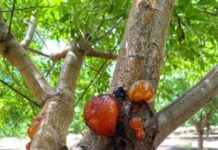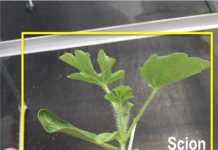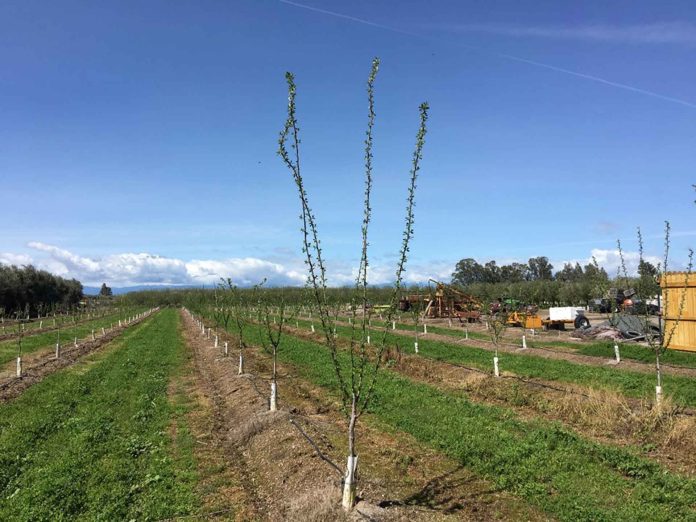
California will likely have a large prune crop in 2019 following favorable bloom conditions and lower yields in 2018. Unfortunately, in prune production with larger crops typically comes smaller fruit, of which there is currently an over-supply in the world market. High production of small fruit world-wide has come at a time when demand for small fruit from consuming nations like China, Brazil, and Russia has been in decline. California handlers have been strongly urging their growers to use shaker thinning to reduce the fruit number during spring and help deliver large, high-quality fruit at harvest.
To be successful, the prune orchard of the future is going to have to thread the needle of achieving earlier production in its life cycle and maintaining high and consistent yields in maturity, all while attaining large average fruit size each year. Prunes come into production later than many other orchard crops, one way to increase early production is to reduce or eliminate severe heading cuts during tree training. Subsequently, yield potential at orchard maturity may be increased over historical production levels in some situations by striking a new balance between spacing and rootstock vigor for increased canopy volume and higher light interception. Finally, the key mechanism for achieving more consistent yields and larger fruit size in prune production has been to thin the crop with mechanical shaking following good bloom conditions like we had this year. Shaker thinning will likely continue to be the foundation of consistent yields for future orchards.
Pruning Prunes: Greater Early Production by Avoiding Heading Cuts During Establishment
University of California (UC) research has shown that earlier and greater production can be achieved in both almonds and walnuts by reducing the severity of pruning during tree establishment. This has been done by reducing or eliminating the use of severe heading cuts (figure 1) during tree establishment. In pruning, “heading cuts” reduce the length of a limb, while “thinning cuts” completely remove the limb. Although historical orchard tree training often calls for severe heading cuts (e.g. cutting back ½ or more of the 1st year growth during the first dormant period), leaving limbs unheaded can lead to earlier fruit production.
Bill Krueger, now a UC Cooperative farm advisor emeritus, tested several pruning regimes for newly planted prune trees from 1996 through 2000. The most successful of these pruning regimes all minimized the severity of pruning. Yield and profitability were greatest in the treatment that selected three to five scaffolds at the first dormant and bent back competing limbs (nearly to, or to the point of breaking to reduce competitiveness). Competing limbs were again bent at second and third dormant, and finally limbs were left unheaded at fourth dormant. In all four years of this treatment, pruning cuts were made for selective thinning (complete limb removal) to help shape the tree into a vase-shape and eliminate competing or crossing branches. Other treatments that both yielded well and had the highest total income selected either 3 or 3-5 scaffolds and either left those scaffolds unheaded or lightly tipped in the first dormant. In the 2nd, 3rd and 4th dormant these other successful treatments had various sequences of either being unheaded (but still making thinning cuts) or leaving the trees completely unpruned. By contrast, the severe pruning treatment that had the lowest cumulative dry yield and income selected three scaffolds at the first dormant and then headed new limb growth back to 30 inches in the 1st through 4th dormant.
You can read the full report from 2000, which is the second listed report at: ucanr.edu/sites/driedplum/show_categories/General_Pruning/
Joe Turkovich, Winters area grower and Chairman of the California Prune Board developed his own minimal pruning training method, which he describes as a modified version of the “long pruning” method described by Krueger and others in the UC Prune Production Manual. First used in the early 1990’s, the goal of his approach is to create an upright canopy framework with a strong interior architecture capable of bearing large crops without the need for wiring, rope, or propping. It allows for early bearing and isolates breakage to flatter, bearing side limbs. It involves the almost exclusive use of thinning cuts as opposed to heading cuts. Turkovich heads the dormant bareroot trees at 40 inches at planting to allow space for vertical separation between the future primary scaffolds. Scaffolds are selected during October of the first year of growth and left unheaded. In May of the 2nd year, the three scaffolds are lightly tipped back (approximate height nine feet) to keep them from bending out of position, and approximately a third of new growth is thinned out (in particular, removing crossing-limbs, while allowing flat fruiting wood to develop). In the dormant period between year two and three (or during the summer of year three) the only pruning that occurs is to select or promote the growth of secondary leaders (two per scaffold). Again, no heading cuts are done, and no attempt is made to “open up the tree”. Between year three & four, again, no heading cuts. Excessive side limbs are removed or tipped to prevent over-bearing and breakage and tertiary leaders are selected or promoted, two per secondary leader. In subsequent years he continues to avoid heading cuts, never topping the trees. If tree height needs to be reduced, leaders are thinned back to strong side upright limbs three to five feet below the top of the tree. On 18′ by 16′ spacing, Turkovich reports this orchard training approach has yielded approximately 0.6 tons in the 3rd leaf, 1.2 in the 4th, 3.0 in the 5th and an average of 4.5-5.5 tons/ac of high-quality fruit in the 6th year and beyond.
Whether utilizing one of the minimal pruning regimes tested by Bill Krueger or the approach utilized by Joe Turkovich, minimizing severe heading cuts during tree establishment can lead to improved early yields.
Tighter Spacing and Greater Light Interception in the Prune Orchard of the Future:
Increased Canopy Volume à Increased Light Interception à Increased Yield Potential
At maturity, higher yields could be achieved in many California prune orchards by capturing more light with the choice of a more vigorous rootstock, and/or planting at a closer spacing. We all know that fruit and leaves grow on branches, and that fruit need the sugar production from neighboring leaves to grow and sweeten. Thus, one way to think about the yield potential of an orchard is how many fruit-leaf groupings (also called bearing units) are spread out over the orchard. In other words, increasing the amount of space in the orchard taken up by the orchard canopy (instead of open, unused space) will increase your yield potential per acre.
One measure of canopy size is how much light that canopy intercepts. Light that is intercepted by the leafy canopy and doesn’t reach the orchard floor is measured as midday photosynthetically active radiation (percent PAR). Work by the laboratory of Bruce Lampinen, University of California Cooperative Extension (UCCE) orchard specialist at UC Davis, has found that for every 1 percent of light that an almond orchard captures there is an average of 40 lbs/ac increased yield in all measured orchards (see figure 2). Lampinen has found this relationship between greater light capture and greater yield potential in both almond and walnut production. Light interception isn’t the only determinant of yield of course, therefore these are “potential” yields and depend on proper irrigation, fertilization, pest and disease management.
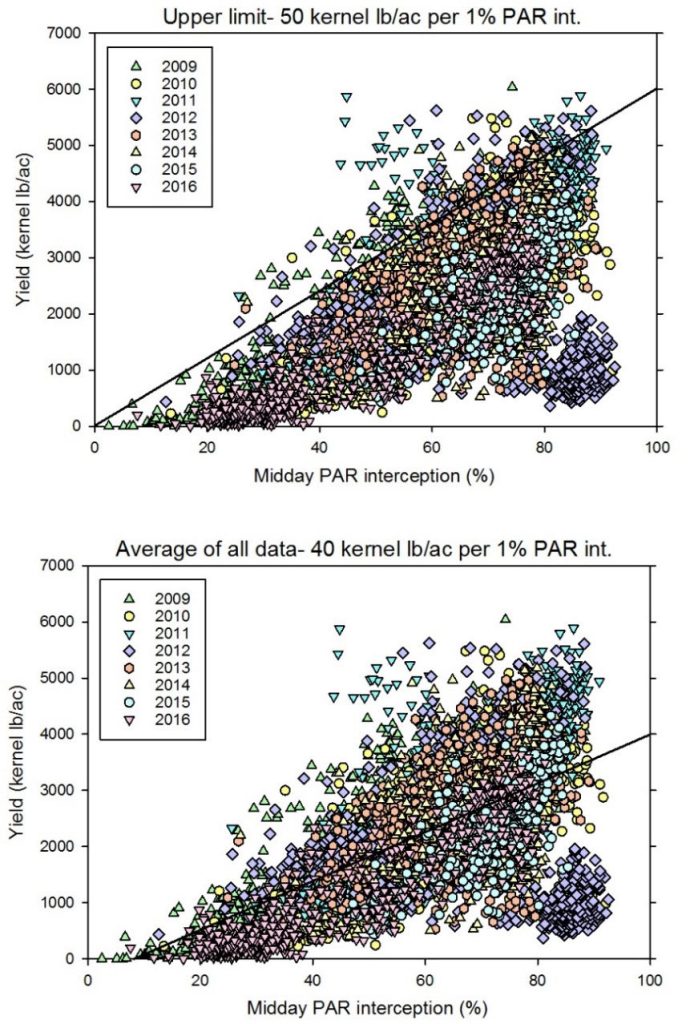
Light Interception and Yield Potential in Prune Production
Although the relationship between canopy light interception and yield has not been as well studied in prune production, there does appear to be a clear relationship from the limited data available (see figure 3). Although there is substantial variation, the denser 14’ x 17’ planting in this example is achieving between 60-80 percent light interception and is clearly out yielding the wider spaced plantings that are only capturing 30-45 percent of midday light, common in many California prune orchards. The 16 foot in-row spacings of the wider plantings appear as discrete trees (they do not touch), while the 14’ x 17’ spacing have created continuous hedgerows (see figure 4). This tighter 14’ x 17’ (183 trees/acre) spacing illustrates the 6-8 dry tons/ac yield potential of prune orchards in excellent cropping years.
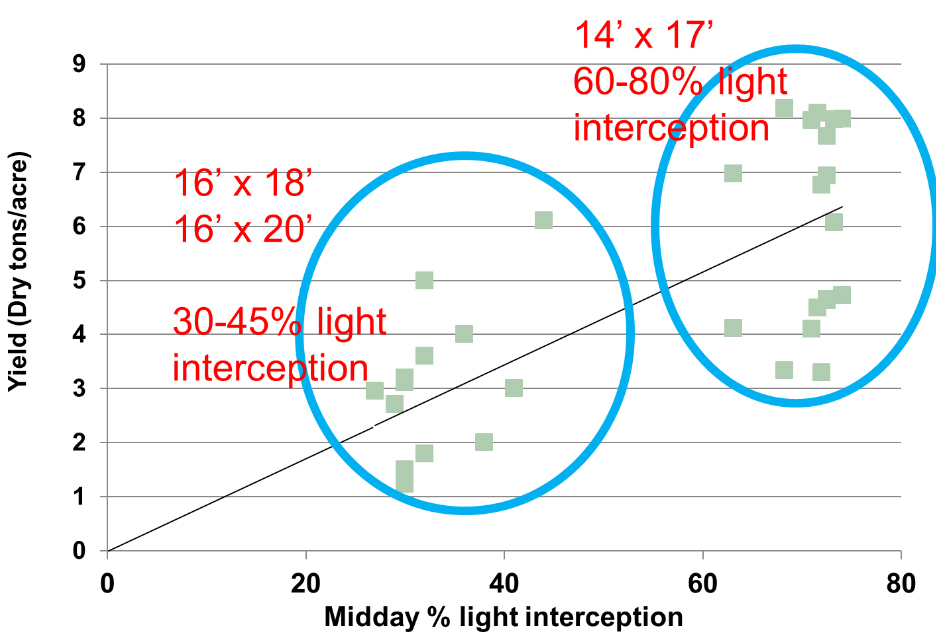
Prune orchard spacing has historically been determined by the constraints of harvest equipment. However, some growers are instead shifting this paradigm and beginning to modify their equipment to get through tighter spacings. Many questions and potential challenges arise due to this shift in paradigm and will be addressed through experimentation by innovative growers and UC researchers.
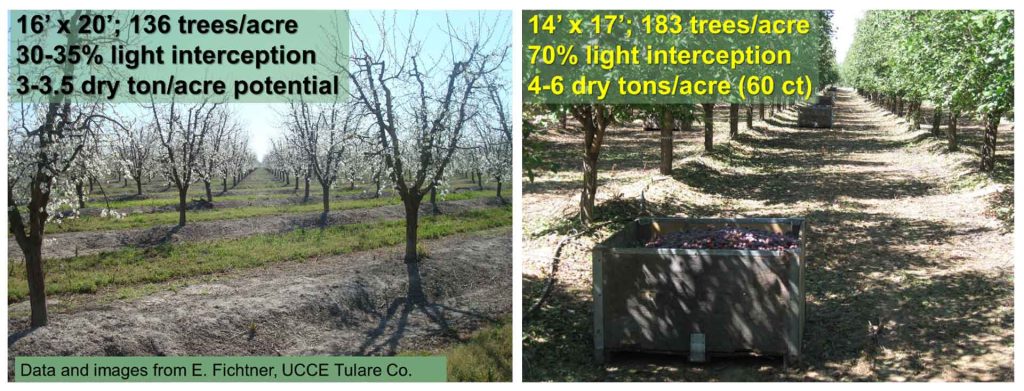
For more considerations impacting spacing and light interception, including rootstock vigor and soil type, per tree costs and mechanical hedging, see: cebutte.ucanr.edu/newsletters/Prune_Notes79781.pdf
Consistent Large Fruit Size
The final component to remaining competitive with the increased production levels in Chile and Argentina, is achieving large, high-quality fruit each and every-year. The key approach to achieving consistent large fruit size is shaker thinning in years like 2019 when a high percentage of flowers set fruit (far too many for the tree to achieve a large average fruit size). Fruit thinning occurs roughly at “reference date” or when 80-90 percent of fruit have a visible “endosperm”.
Endosperm is a clear gel-like glob that can be excised with a knife point from the blossom end of the seed (see figure 5). Reference date is roughly one week after the pit tip begins to harden and timing is typically late April or early May. Although the earlier thinning is done, the great the effect will be on final fruit size at harvest, if you thin too early you can damage the tree without effectively removing fruit.
UC Cooperative Extension orchard farm advisor Dani Lightle developed a great guide to shaker thinning that computes the required calculations for you: sacvalleyorchards.com/prunes/horticulture-prunes/prune-thinning-calculator/
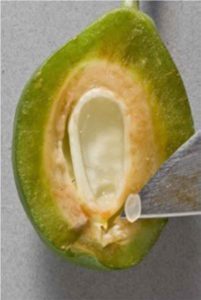
Thinning is a critical practice for several reasons. When production of small fruit is up worldwide at the same time demand for small fruit is in decline, achieving large average fruit size is an absolute imperative. Not only do small fruit have substantially less value (or even no value in some cases), they are costlier to harvest and dry. Setting a large crop of small fruit can also be a great stressor on an orchard creating a large sink for potassium demand and causing limb breakage. Finally, since not every year’s bloom creates favorable conditions for fruit set, over-cropping can set up a vicious cycle of having fewer flowers that will be blooming during an uncertain bloom period in the subsequent year. In other words, thinning enables a high flower density each year. Even if bloom conditions are poor and set is low, a low percentage of fruit set from a high number of flowers is much better than low set from only a few flowers. Mechanical thinning enables the production of higher-value fruit, avoids the drain of costly small fruit and sets up the orchard for more sustainable year-to-year production.
Three key practices for maximizing orchard productivity are utilizing reduced severity of pruning during canopy training, achieving higher yield potential by maximizing canopy light interception and consistently attaining large average fruit size through thinning. These practices may be part of what gives the California prune orchard of the future a competitive edge in the global market.
This work is made possible by the funding support of the California Prune Board. Special thanks to Mark Gilles (Sunsweet) for his input on prune orchard spacing both historically and currently. Special thanks also to Joe Turkovich who kindly provided the details of his modified version of the “long pruning” method.











